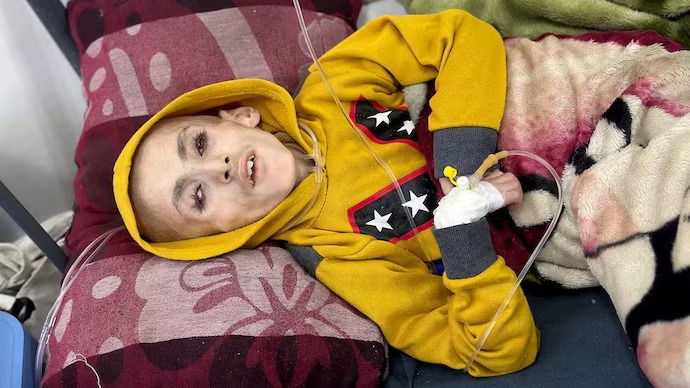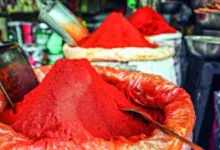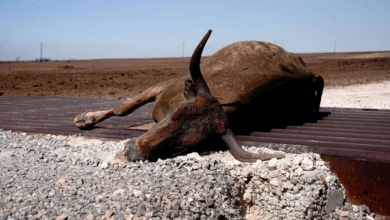Starving youngsters clog hospital rooms in Gaza as a famine approaches
Fadi al-Zant, six, is very emaciated; as he lies in bed in the Kamal Adwan hospital in northern Gaza, where starvation is raging, his ribs can be seen sticking out from beneath his leathery skin.
Fadi’s fragile legs are no longer able to carry him to a walking position.

Before the war, pictures of Fadi depict him as a happy, healthy-looking little boy, standing next to his taller twin with his hair combed back and dressed in blue jeans. He might be seen dancing at a wedding with a little girl in a brief video clip.
Fadi has a disease called cystic fibrosis. His mother, Shimaa al-Zant, claims that prior to the fighting, he was taking medication that his family was unable to get and eating a well balanced range of food that was no longer accessible in the Palestinian enclave.
“His health is deteriorating. He is becoming more feeble. He continues losing his capacity to accomplish things,” she said in a freelancer’s film that Reuters was able to secure. “He’s at his breaking point. He immediately collapses when I assist him in standing up.”
Almost five months after Israel began its military and air assault in response to the October 7 offensive by Hamas, medical professionals and relief organizations report that there are severe shortages of potable water, food, and medication in Gaza.
In addition to treating Fadi, the majority of the 27 children reported to have died in recent weeks from malnourishment and dehydration in Gaza, which is controlled by Hamas, were also receiving care at the Kamal Adwan hospital.
According to the ministry, more people lost their lives at the northern Gaza City’s al-Shifa Hospital as well as in Rafah, the southernmost city where more than a million Palestinians have fled Israel’s onslaught, according to the UN assistance agency.
Last Monday, Reuters visited the al-Awda health center in Rafah, organized by nursing personnel who allowed the news agency unrestricted access to the ward, where they saw ten severely malnourished youngsters. The fatalities announced by the government could not be independently confirmed by Reuters.
The world’s hunger monitor, the Integrated Food Security Phase Classification (IPC), said in an assessment on Monday that famine would strike northern Gaza, where 300,000 people are besieged by violence, between now and May if immediate action is not taken.
For almost two thirds of the northern population, “extremely critical levels of acute malnutrition and mortality” were predicted by the most probable scenario in the analysis. Global assistance organizations and UN agencies comprise the IPC.
The military organization in charge of transferring supplies to Gaza, Israel’s COGAT, did not directly reply to inquiries from Reuters on the deaths of kids from starvation and dehydration. It said Israel placed no restrictions on the quantity of help that may be received.
Israeli government spokesman Eylon Levy wrote on X after the IPC assessment, stating that Israel was taking steps to support “delivery efforts” to the north and that the number of food vans had grown in March.
Regarding the evaluation, he said, “It’s a bad assessment, based on an out-of-date picture.”
In a statement released to the public, USAID Administrator Samantha Power described the IPC evaluation as “a horrific milestone.” She urged Israel to expand its land lines and run all of the crossings.
Senior Hamas spokesman Sami Abu Zuhri responded to a Reuters inquiry over the IPC report by saying that Israeli Prime Minister Binyamin Netenyahu was “defying the world and pursuing the killing of the Palestinian people in Gaza by bombs and starvation.”
A request for comment was not immediately answered by US officials.
According to UN relief organizations, the “overwhelming obstacles” to delivering supplies to Gaza’s northern region can only be solved by a truce and the reopening of border crossings that Israel has blocked since October 7.
DISAPPEARING
In happier days, according to his mother, Fadi loved Levantine grill cuisine called chicken shawarma. He also consumed a lot of fruit and milk.
She said that the family left their heavily bombed, heavily damaged house in Gaza City’s al-Nasr neighborhood when the conflict broke out. She said that before reaching Beit Lahia, they had been relocated four times.
About two months ago, Fadi’s health started to worsen, and Zant said that he was taken to Kamal Adwan hospital. There was a shortage of Creon, the medication that patients with cystic fibrosis need to replace pancreatic enzymes that aid with food digestion. Fadi sometimes experienced ten episodes of diarrhea in one night.
The infant weighed 30 kg (66 lb) before the war. He only weighs 12 kg (26 lb) now, according to his mother.
“He used to eat healthfully. There was therapy accessible for him. He had a full face. He seemed to be a healthy youngster. Along with his sibling, he attended kindergarten,” she said.
When asked whether Creon was available, COGAT said that Israel had “not refused a single shipment of medical supplies.”
It was not possible for Reuters to independently confirm with hospital authorities if any such shipments had been stopped or how much the supply of Creon had been affected.
According to the Gaza Health Ministry, the children’s situations deteriorated due in part to pharmaceutical shortages.
According to UN organizations, the dangers are progressively increasing, not just for children with pre-existing medical issues like Fadi but also for many others in Gaza.
UNICEF, the UN agency for children, said on Friday that almost one in three children in northern Gaza under the age of two are acutely malnourished—twice as many as in January.
The most dangerous kind of malnutrition, severe wasting, affects 4.5% of children in shelters and health facilities that UNICEF and its partners visit.
“Unless fighting stops and aid agencies have full access throughout Gaza, then hundreds if not thousands, more children could die of hunger,”
In a statement released together with the World Food Programme on Tuesday, UNICEF executive director Catherine Russell said.
According to the IPC research, 1.1 million people in Gaza, or half of the population, are predicted to experience severe food shortages, resulting in famine and deaths in homes, should Israel carry out its planned operation in Rafah.
Col. Elad Goren of COGAT told reporters last Thursday that food availability in the enclave’s south and center remained steady.
Human Rights Watch said at the end of February that Israel was impeding the entrance and delivery of fuel and life-saving supplies into Gaza, in addition to the provision of essential services. It said that this constituted “collective punishment,” which is illegal under international humanitarian law and a war crime.
Beyond its commitments, COGAT told Reuters, Israel was making “extensive efforts to increase the amount of aid that enters Gaza.”
“Any claims otherwise, including claims regarding collective punishment, are baseless in both fact and law,” it said.
RAFAH
More than a dozen mothers were sitting or standing and caring for their undernourished children at the al-Awda health center in Rafah.
Although the parents of two of the children showed Reuters images showing them looking much better than they do today, the majority of the youngsters in the unit already had health issues before the conflict, according to their relatives.
Yazan al-Kafarna, 12, a cerebral palsy sufferer, passed away in southern Gaza on March 4, a few days after Reuters captured images of him that revealed his extreme malnourishment.
Amira Abu Juwaiyad, the ward nurse, said that 10 to 15 instances of “catastrophic” illnesses were being admitted to the hospital every day and that there was not enough milk available for the newborns. The amount of milk that was accessible before the battle was not mentioned by Abu Juwaiyad.
Cradling her paraplegic and epileptic daughter, Israa, age five, was Umm Mesbah Heji.
Israa has shed a significant amount of weight and her medications are no longer accessible. She added that before the war, Heji would give her rice for supper, liver for lunch, and eggs and milk for the morning. She sometimes offered her fruit and yogurt.
“I am aware of her hunger. The food she consumes isn’t accessible,” she said, adding that she feels sorry for her kid “a hundred times a day.”
The severe food shortage is made worse by the diarrheal disease. Malnutrition is accelerated by dehydration from diarrhea, which the World Health Organization claims is common in the mass tent towns where displaced people squat together without access to clean water or sanitation.
Acute hunger may have the impact of lowering immunity to some stomach illnesses.
90 percent of Gaza’s children under five were afflicted with one or more infectious illnesses, according to a report released by the World Health Organization last month. Of those, 70 percent had experienced diarrhea in the two weeks before the conflict, a 23-fold rise in instances.
The physical signs of malnutrition and dehydration were identified by US physician Kerstin Hanson, who works on nutrition for the global nonprofit organization Medecins Sans Frontieres.
Kids become less alert and sluggish. Their skin becomes less puffed, allowing it to remain in its deformed state if pushed out of shape. The eyes get sunken. The body became malnourished.
Persistent malnutrition may impede the development of the body and brain, even in children who were healthy before the war.
According to Hanson, a child’s body stops developing as soon as severe starvation sets in. After then, it stops doing everything except essential tasks. “Your heart and lungs will keep functioning, but maybe there isn’t enough energy to keep your immune system functioning,” she said.
Following that, the body would “kind of start eating itself,” drawing energy from fat, muscle, and other sources to maintain breathing and blood flow. It would eventually simply stop working.
If malnutrition persists, its effects on development may be irreversible, even if it does not reach that risky level, according to Hanson. Children may never regain the growth centimeters they have lost.







